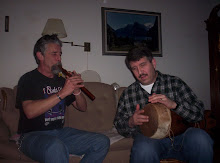For years, a family story has been told and retold. When my mom and dad were married, my dad smoked a pipe. As my dad learned more about mom's side of the family, he became very close with Little Grandma Miriam. When mom and dad would go to Akron to visit, Grandma Miriam would see him and call out "Duduk, Bill, duduk." Or in her accent, "Doodook, Beel, doodook."
For years we assumed that duduk meant "pipe" and it may very well mean that. But as I learned about the Armenian woodwind instrument, the Duduk, it dawned on me that Grandma was making a wonderful joke. She was likening my dad's use of the tobacco pipe to the instrument, the Duduk.
I am so gladdened to think of this and how Grandma's memory comes back to me whenever I play the Duduk. I have the picture you see below on my wall and often play tunes to her. She is alive again...
Sunday, October 17, 2010
Subscribe to:
Post Comments (Atom)


No comments:
Post a Comment